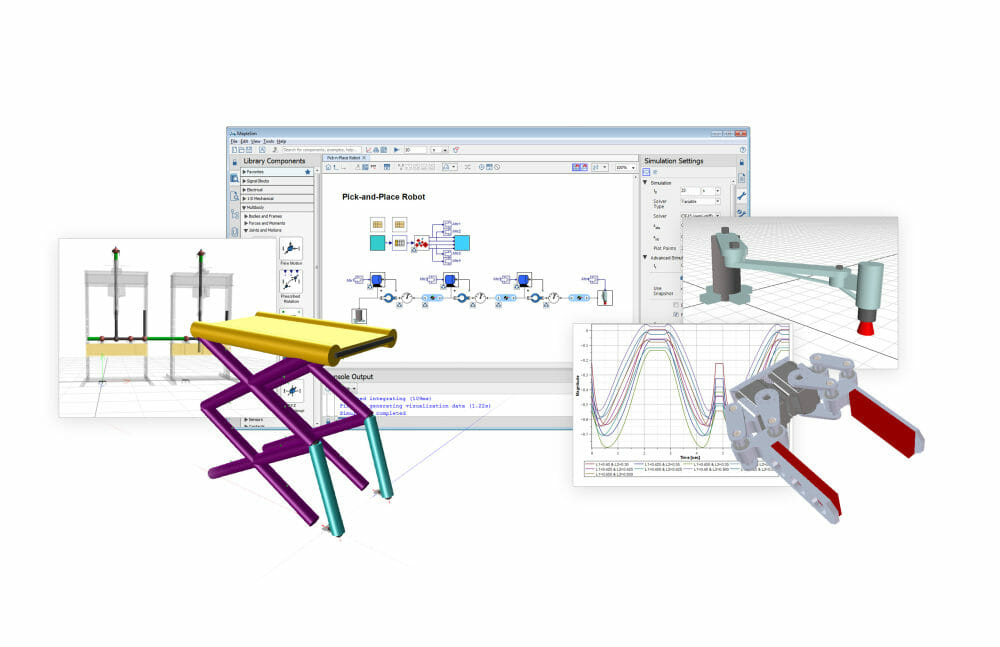Improved development and analysis tools in MapleSim 2017 enable easy creation of Digital Twins and other virtual prototypes
Waterloo, Canada; September 28, 2017: Maplesoft™ today announced a major new release of MapleSim™, an advanced system-level modeling tool that enables innovation and reduces development risk, allowing engineering organizations to create better products, faster.
MapleSim is a natural environment for modeling multidomain systems that supports the rapid creation and testing of initial concepts so engineers can try out more ideas in less time, identify and prevent unexpected interactions between different domains, and generate computationally efficient models. MapleSim is used across a wide variety of applications and industries, including the creation of physics-based Digital Twins. Because Digital Twins in MapleSim do not require test data to predict behavior, they can be used for conceptual design as well as validating product performance, design changes, and diagnostics. The latest release provides new and improved model development and analysis tools, expands modeling scope, introduces new deployment options, and strengthens toolchain connectivity.
MapleSim 2017 includes significant additions to the collection of built-in interactive model analysis tools. Choosing the correct initial values for a model is an extremely important and often extremely difficult task, and the new Initialization Diagnostics App provides insight into the initialization process to help engineers determine how the initial values are computed and what actions are needed to adjust them. The new Modal Analysis App helps engineers explore and understand the natural vibration modes of their mechanism, so they can identify which modes will have the biggest impact on the design and determine how to reduce the vibration in the final product.
Other improvements include over 100 new components, including expansions to the Electrical and Magnetic libraries. MapleSim 2017 also provides a new Modelica® code editor that makes it easier to create Modelica-based custom components, new options that simplify the creation of custom analysis tools, and enhanced support for connectivity with other modeling tools through FMI export. The MapleSim family of products now also includes MapleSim Explorer, a cost-effective deployment solution that enables organizations to make the knowledge embedded in their MapleSim models available to more people.
In addition, the new MapleSim 2017 release includes a new add-on component library. The MapleSim Heat Transfer Library from CYBERNET provides a comprehensive view into the heat transfer effects present in a model, enabling engineers to refine their design to improve performance and avoid overheating. The MapleSim Heat Transfer Library from CYBERNET is useful for any situation where heat generation is a concern, especially when there are moving boundaries between heat generating components, such as motors, batteries, printers, and manufacturing equipment.
“Maplesoft is committed to helping companies translate their engineering expertise into a system-level modeling tool, so they can truly reap the rewards that come from using this approach,” says Dr. Laurent Bernardin, Chief Operating Officer and Chief Scientist at Maplesoft. “MapleSim helps companies use Digital Twins and other virtual prototypes to get key insight along the entire engineering design process. It also helps organizations capture, deepen, preserve, and leverage their engineering knowledge, so they avoid common pitfalls and experience success in their modeling projects.”
MapleSim is available in English, Japanese, and French.
About Maplesoft
Maplesoft provides engineers with the tools and expertise they need to enable a model-driven innovation process that helps manage design complexity. Offering experts in a variety of engineering fields, extensive experience in model-based design, and the superior system-level modeling and analysis tools MapleSim and Maple, Maplesoft helps companies reduce development risk and bring high-quality products to market faster. Through Maple, Maplesoft also provides a complete concept-to-deployment environment for advanced analysis and rapid development of technical applications and engineering calculation tools. Maplesoft products and services are used in machine design, robotics, aerospace, automotive, and many other fields where engineers face complex challenges. Customers include Boeing, FLSmidth, Ford, Google, Intel, NASA, and Samsung.
Maplesoft is a subsidiary of Cybernet Systems Group. For further details, please visit www.maplesoft.com







